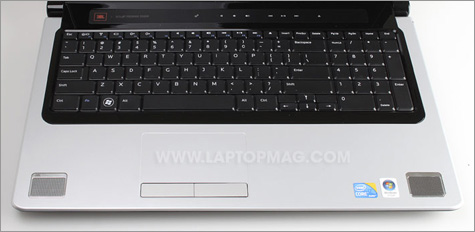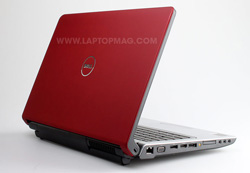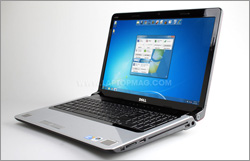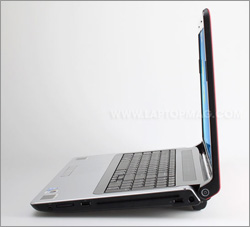Laptop Mag Verdict
A blazing quad-core notebook that delivers an excellent multimedia experience for an affordable price.
Pros
- +
Strong performance for the money
- +
Crisp, loud JBL speakers
- +
Relatively long battery life
- +
Reasonably priced
Cons
- -
Full HD display costs extra
- -
Bottom gets hot
- -
Keyboard has some flex
Why you can trust Laptop Mag
Bleeding-edge performance at a reasonable price. That's what Dell delivers in the Studio 17, a $1,164, 17.3-inch multimedia laptop. For hundreds of dollars less than other quad-core systems, it offers comparable speed and even better battery life. The design of this machine doesn't exactly wow, and you'll need to pay more to get a full HD screen, but for those who crave power and a big screen, this notebook is a winner.
After we completed most of our testing on the Studio 17, our review sample failed to boot, prompting us tosend the system back for repairs. Dell says our issue was likely an isolated incident, and we will update this review once we get in a second unit for evaluation. We reserve the right to change the rating.
Design
The Studio 17 doesn't represent much of a departure from other Studio notebooks that have come before it, even the 14-inch, optical drive-less Dell Studio 14z. It has a satin lid (available in five colors; ours was Ruby Red) that feels soft to the touch and (mostly) masks fingerprints. Inside, the chassis mixes a glossy gray palm rest with a matte black keyboard and a piano black panel above the keyboard, complete with number pad. While it lacks some of the refinements of the high-end Studio XPS line, such as leather accents on the lid and flat keys, it borrows a few design elements, such as the glowing power button. The final product is handsome, but not as sophisticated as the 17-inch Apple MacBook Pro, Dell Studio XPS 16, or even the HP Envy 15.
As a desktop replacement, though, the Studio 17 adds a few multimedia flourishes that its smaller siblings lack, including touch-sensitive multimedia controls and twin JBL speakers, each of which sit in a corner of the palm rest. The speaker grilles' chrome styling is a nice touch. The multimedia controls blink when you touch them, and they responded well to all of our taps.
Even for a 17-inch notebook, the Studio 17 is heavy. At 7.8 pounds, it weighs 0.8 pounds more than the Acer Aspire 7735Z and is 1.2 pounds heavier than the 17-inch unibody MacBook Pro. However, it's sized similarly to other 17-inchers.
Heat
Like other Core i7 notebooks, the Studio 17 generates a good deal of heat. After playing an HD Hulu video (Legend of the Seeker) at full screen for 15 minutes, the front underside of the system measured 112 degrees Fahrenheit. (We consider anything above 100 degrees uncomfortable.) You likely won't use the Studio 17 in your lap, but some may want to consider a cooling dock or pad for the notebook. The top stayed somewhat cooler: the touchpad registered a balmy 98 degrees, and the space between the G and H keys was 96 degrees.Like the Studio 17's boot issue, ourheat test results may be an abnormality andwe'll re-test the review unit that Dell is sending us.We'llupdate this review with ourfindings soon.
Keyboard and Touchpad
Despite the Studio 17's large size, the keyboard panel felt surprisingly unstable. We noticed a lot of flex as we pounded out words, which caused us to slow down and type at a more leisurely pace. The keys produced a noticeable amount of noise, too, even though they have a fairly shallow pitch. Nevertheless, even when we felt we were typing gingerly, we still managed to complete the Ten Thumbs Typing Tutor test at a rate of 86 words per minute, which is just two words slower than our personal best. As for the touchpad, we enjoyed its large, 4.0 x 2.3-inch size, even though it does not support any touch gestures. The pad itself had very little friction, making it easy to navigate the desktop. The ample buttons were easy to press as well, although some might find them too mushy.

Click to enlarge
Display and Sound
While the 17.3-inch display on our Studio 17 wasn't full HD, its 1600 x 900 resolution is pretty standard as an entry-level resolution. To get a 1080p screen, you'll need to cough up an extra $175. Our display looked bright and crisp as we watched an episode of How I Met Your Mother on DVD, but the picture began to look washed out as we pushed the lid forward. However, we were pleasantly surprised by how easy it was to watch the show from the sides, especially given the display's glossy finish.
Although they're small, the JBL speakers produced impressive sound. As soon as we fired up our DVD, we could hear and feel the sound vibrating from the speaker grilles. For one, it made our movie-watching experience more immersive, since the sound quality was far less tinny than what you'd normally get from a notebook. And when we listened to music, from funk by James Brown to guitar riffs by Frank Zappa, we were able to make out lots of instruments. As for the volume, it was loud enough for us to keep it at its median level, or even lower.
Ports and Webcam
In addition to three USB ports (one of which doubles as an eSATA port), the Studio 17 has all of the audio/video ports you could want: HDMI output for hooking it up to a high-def TV or monitor, as well as DisplayPort and standard-def VGA. It also has a microphone port and two headphone ports (smaller notebooks almost always offer just one, if not a combined port for mics and earphones). Rounding out the mix is a FireWire port, an 8-in-1 memory card reader, a 34mm ExpressCard slot, an Ethernet jack, and a slot-loading 8X DVD burner.
The 2.0-megapixel camera, whose resolution is higher than the typical 1.3-MP we're used to seeing, took detailed still photos; we could even make out the shine in our hair and the wrinkles in our shirt. However, the lighting had a greenish tint. Even more than the image quality, what we like most about the webcam is the Dell Webcam Center, a console that features a generous amount of fun filters and avatars, as well as a sleek black-and-gold UI that's easy to navigate.
Performance

Click to enlargeThanks to a new quad-core 1.6-GHz Intel Core i7 processor, part of a high-performance series designed with gamers and power users in mind, as well as 4GB of RAM and a 7,200-rpm hard drive, the Studio 17 notched 5,207 on PCMark Vantage, a Windows benchmark. That's more than 1,100 points above the desktop replacement category average (4,074), although another new quad-core Intel Core i7 machine, the $1,349 Acer Aspire 8940G, scored 5,962.
Meanwhile, the Studio 17's 7,200-rpm, 320GB hard drive transferred a 4.97GB mixed media folder at an impressive rate of 28.6 MBps. Although that's still no match for systems equipped with SSDs, such as the Toshiba Qosmio X505 (67.9 MBps), it still bests other quad-core systems running traditional hard drives, such as the ASUS G51J-A1 (27.2 MBps). The desktop category average (24.9 MBps) falls below all of these scores.
The Studio 17 had no problem keeping up as we switched between half a dozen open tabs in Internet Explorer, reading stories on NYTimes.com, streaming music from Slacker and a video from YouTube, and perusing two online shopping sites. Even when we started running a full scan in McAfee SecurityCenter, we didn't notice any performance hiccups.
The Studio 17 performed with blazing speed on heavy duty tasks. It took just 3:16 to transcode a five-minute-and-five-second MPEG-4 clip to AVI using the program HandBrake. When we performed the same task using Oxelon Media Converter, a multithreaded app which takes advantage of the Core i7's four processing cores, that time dropped to a jaw-dropping 1:19. To put that in context, the average desktop replacement--most of which have been dual-core systems--takes 5:32, over four minutes longer. However, there are some quad-core systems that performed the same test in even less time. The $1,499 ASUS G51J-A1, for instance, which has the same 1.6-GHz Core i7 processor, completed the test in 1:01 using Oxelon.
Graphics
While the Studio 17 is no match for desktop replacements that are marketed explicitly as gaming rigs, it has enough muscle to play the latest titles. Its ATI Radeon 4650 graphics card notched 6,494 on the gaming benchmark 3DMark06. That showing falls just short of the category average (6,610), but is far behind the likes of the ASUS G51J-A1 (9,424) and Toshiba Qosmio X505 (8,313).
When we ran World of Warcraft at a reduced resolution of 1024 x 768, the Studio 17 ran at a decent (but not terrific) frame rate of 60 frames per second. When we cranked the resolution to its maximum (1600 x 900), the notebook maintained a playable 30 fps. Likewise, with Far Cry 2, we saw rates of 82 fps (1024 x 768) and 29 fps (1600 x 900).
In Google Earth, a less graphically demanding program, we flew around the world smoothly. Getting to The Museum of Modern Art in New York City took 9 seconds, and loading all of the 3D buildings took 5 more, which is faster than what you'd see with a smaller or more underpowered notebook.
Battery Life and Wi-Fi
Armed with a nine-cell battery, the Studio 17 delivered above-average battery life--3:34 minutes on our Wi-Fi surfing test--an impressive feat given that the desktop replacement category average is only 2:35, and that Intel's Core i7 processor, in particular, is an even larger energy hog.
Unfortunately, the Studio 17's wireless scores were lower than the category average, thanks largely to the wireless-G radio. (We think any notebook with a starting price over a grand should come with 802.11n standard.) Its throughput of 17.5 Mbps at 15 feet and 16.3 Mbps at 50 feet, while not bad, is noticeably weaker in comparison to the category average (20.1 and 16.4 Mbps). That said, having an 802.11g card didn't stop us from loading five tabs, including Slacker and YouTube, with an 802.11g router sitting on the other side of our apartment.
Energy Efficiency
It took 2:58 hours to recharge the Studio 17's battery, consuming 12424.4 watts in the process. When this is divided by its battery life (to determine its LAPTOP Battery Efficiency Rating; lower is better), the Studio 17 scored 58.1. That's comfortably below the category average of 70.4. This notebook is slightly more efficient than the Toshiba Qosmio X505 (58.4), but not nearly as frugal as the Acer 8940G (36.7).
Software and Warranty

Click to enlargeThe Studio 17 comes with a good deal of bundled software and trialware. These programs include: Dell DataSafe Online (Dell's hosted online backup service; 2GB come free); a trial of McAfee SecurityCenter; a trial of Microsoft Office Home and Student 2007, including a compatibility pack and PowerPoint viewer; and Roxio Burn. At least it's missing other infamous bloatware programs, such as Google Desktop or the Yahoo Toolbar. Out of the box, it took 1:10 to boot up, which is about 10 seconds slower than average.
In addition to this trialware, the Studio 17 also comes with Dell's own software, the Dell Dock. This dock can sit anywhere on your desktop, and features loads of bright, candy-colored icons from which you can launch key programs, such as your favorite browser or photo editing program. The dock takes a task-oriented approach, meaning you might decide first that you want to work with photos, and then choose a program based on what, specifically, you want to do (say, Google Picasa for editing photos on the desktop, or Dell Webcam Center for taking them). Users can customize which applications appear in this dock, which categories they're organized under, and what each program is named.
Back when Vista was the standard OS, the dock was useful because it gave users easier access to their favorite applications. But now that Windows 7 offers an improved taskbar that allows users to "pin" their favorite programs and files, the dock seems somewhat redundant. We imagine more novices gravitating towards the dock who might not be as familiar with the revamped taskbar.
The Studio 17 comes with a standard one-year limited warranty, including 24/7 tech support. To find out what we like--and don't like--about Dell's technical support, click here.
Configuration Options
The Studio 17 starts at $699. However, quad-core systems (such as the configuration reviewed here) start at $1,099. Processor options run the gamut from dual-core Pentium to Core 2 Duo and Core i7. If you want even more speed than our system, you can step up to the 1.73-GHz Core i7 (which overclocks to 3.06-GHz), but you'll pay an extra $350. Depending on the configuration you choose, you can expect at least 3GB of RAM, but the Studio 17 can accommodate up to 8GB.
The hard drive at that entry-level $699 price is 160GB/5,400 rpm, but as you move up in price there are plenty more options. You can also buy 7,200-rpm hard drives that range in capacity from 250GB to 500GB ($75). It's also possible to pair two 7,200-rpm, 500GB drives for a total of 1TB of space ($150) or pair two 7,200-rpm, 320GB drives for $100.

Click to enlargeAlthough our configuration had a nine-cell battery, a six-cell option is also available. A DVD burner is standard, but a Blu-ray player is a $150 option. In addition to wireless-G, you can configure the Studio 17 with a wireless-N radio by either Dell or Intel.
The Studio 17 is also available with a multitouch-enabled display for an additional $200. In addition to the display, which can recognize up to four finger inputs, it also comes with Dell Touch Zone, a proprietary suite allowing users to play games and edit photos, as well as CyberLink YouPaint and TouchCam, which are designed to be used with fingers.
Verdict
Although it costs a reasonable $1,164, the Dell Studio 17 has the power of a much more expensive notebook: a blazing quad-core Intel Core i7 processor that's perfect for multitaskers and multimedia fiends, a full gigabyte of dedicated graphics memory, a fast, 7,200-rpm hard drive, and a nine-cell battery that outlasts other desktop replacements. Sure, you'll get a more refined design and even stronger performance as you move up to more tricked-out systems, but the Studio 17 delivers a lot of value.
Dell Studio 17 (Core i7) Specs
| Bluetooth | Bluetooth 2.1 |
| Brand | Dell |
| CPU | 1.6-GHz Intel Core i7-720QM |
| Card Slots | 8-1 card reader |
| Company Website | http://www.dell.com |
| Display Size | 17.3 |
| Graphics Card | ATI Mobility Radeon HD 4650 |
| Hard Drive Size | 320GB |
| Hard Drive Speed | 7,200rpm |
| Hard Drive Type | SATA Hard Drive |
| Native Resolution | 1600x900 |
| Operating System | MS Windows 7 Home Premium (64-bit) |
| Optical Drive | DVD /- RW |
| Optical Drive Speed | 8X |
| Ports (excluding USB) | Ethernet, eSATA/USB, Dual Headphone, VGA, DisplayPort, Microphone, HDMI, Firewire |
| RAM | 4GB |
| RAM Upgradable to | 8GB |
| Size | 16.3 x 11.0 x 1.6 inches |
| USB Ports | 2 |
| Video Memory | 1GB |
| Warranty/Support | One-year limited/24/7 toll-free phone |
| Weight | 7.8 pounds |
| Wi-Fi | 802.11b/g |
